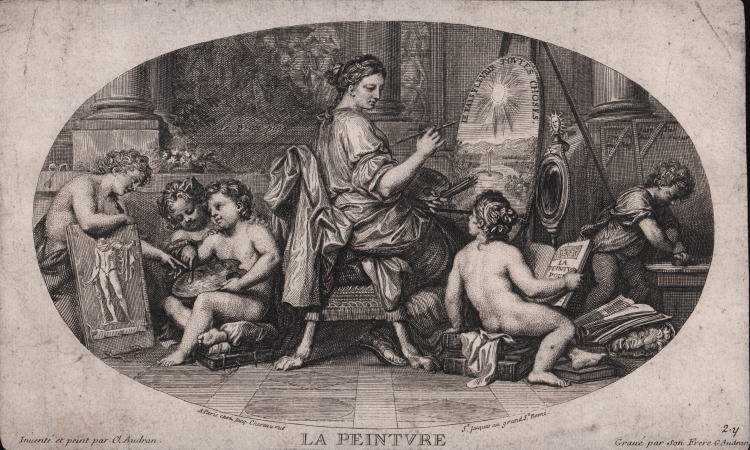



| Reference: | S44823 |
| Author | Girard AUDRAN |
| Year: | 1690 ca. |
| Measures: | 265 x 160 mm |


| Reference: | S44823 |
| Author | Girard AUDRAN |
| Year: | 1690 ca. |
| Measures: | 265 x 160 mm |
Etching and engraving, circa 1690, signed at lower right.
From the set of the Seven Liberal Arts, after a drawing of his brother Claude II Audran.
This work is part of the "Le Cabinet des beaux Arts ou Recueil d'Estampes gravées d'apres les Tableaux d'un plafond ou les beaux Arts sont representés Avec l'explication de ces memes Tableaux" (Paris, G. Edelinck) 1690; containing 12 plates after a ceiling painting representing Apollo, Mercury, Minerva and allegories of the Liberal Arts, by and after various French artists.
A good impression, printed on contemporary laid paper, trimmed to the platemark, traces of surface dirt on recto, glue on verso, overall in good condition. Example of the second issue published by François Chereau.
Girard Audran, sometimes wrongly called Gérard, was an engraver and print publisher, with address at Les Gobelins, Paris (c.1674-c.1677) and Rue Saint-Jacques, Les deux piliers d'or (c.1677-1703). Brother of Claude II. Sent to Italy in 1666-8. Founder of school of engraving in Paris, working with Le Brun on the Battles of Alexander 1672-8. Publishing from c.1677 works by Benoit Audran, Sebastien Le Clerc and others. After his death in 1703 the business continued by his widow (as la veuve Audran) at the same address, until 1718 when part of business (including the address) bought from her by François Chereau.
Bibliografia
Préaud, Maxime (1998), "Edelinck, Gérard", vol. 9, p. 718, in The Dictionary of Art, edited by Jane Turner.
Girard AUDRAN (Lione, 1640 – Parigi, 1703)
|
Gérard Audran (or Girard Audran) (2 August 1640 – 26 July 1703), was a French engraver of the Audran family, the third son of Claude Audran. He was born in Lyon and was taught the first principles of design and engraving by his father. Following the example of his brother, he went to Paris to perfect himself in his art. In 1666, he engraved for Le Brun Constantines Battle with Laxentius, his Triumph, and the Stoning of Stephen, which gave great satisfaction to the painter, and placed Audran in the very first rank of engravers at Paris. The next year he set out for Rome, where he resided three years, and engraved several fine plates. He is reputed to have worked for or trained with Carlo Maratta. That great patron of the arts, J. B. Colbert, was so struck with Audran's works that he persuaded Louis XIV to recall him to Paris. On his return, Audran applied himself assiduously to engraving, and was appointed engraver to the king, from whom he received great encouragement. In the year 1681 he was admitted to the council of the Royal Academy. He died in Paris. His engravings of Le Bruns Battles of Alexander are regarded as the best of his numerous works. Gerard published in 1683 a work entitled Les Proportions du corps humain mesurés sur les plus belles figures de l'antiquité
|
Girard AUDRAN (Lione, 1640 – Parigi, 1703)
|
Gérard Audran (or Girard Audran) (2 August 1640 – 26 July 1703), was a French engraver of the Audran family, the third son of Claude Audran. He was born in Lyon and was taught the first principles of design and engraving by his father. Following the example of his brother, he went to Paris to perfect himself in his art. In 1666, he engraved for Le Brun Constantines Battle with Laxentius, his Triumph, and the Stoning of Stephen, which gave great satisfaction to the painter, and placed Audran in the very first rank of engravers at Paris. The next year he set out for Rome, where he resided three years, and engraved several fine plates. He is reputed to have worked for or trained with Carlo Maratta. That great patron of the arts, J. B. Colbert, was so struck with Audran's works that he persuaded Louis XIV to recall him to Paris. On his return, Audran applied himself assiduously to engraving, and was appointed engraver to the king, from whom he received great encouragement. In the year 1681 he was admitted to the council of the Royal Academy. He died in Paris. His engravings of Le Bruns Battles of Alexander are regarded as the best of his numerous works. Gerard published in 1683 a work entitled Les Proportions du corps humain mesurés sur les plus belles figures de l'antiquité
|